This was published 1 year ago
It began as a holy day. It ended with barbarity and bravery on gruesome display
By Matthew Knott and Kate Geraghty
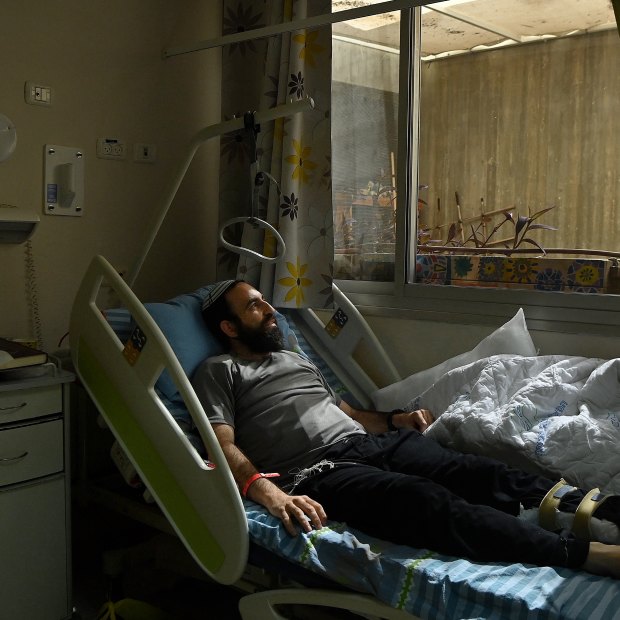
Rabbi Shachar Butzchak being treated in the Soroka Medical Centre for bullet wounds in his leg after being shot during the Hamas attack in Ofakim, Israel.Credit: Kate Geraghty
Be’er Sheva: A shoot-out between Israeli cops and Hamas terrorists. Kalashnikov rifles and rocket-propelled grenades. Kill or be killed. Daniel Damri’s story of October 7 sounds like a video game. But as he recounts his survival to us from his hospital bed it was clear this wasn’t virtual reality, it was reality. The limitless barbarity and bravery of which mankind is capable is on gruesome display, here in the dusty plains of the Negev Desert.
Damri’s plan for Saturday was simple: to relax with his wife and three young children in their hometown of Be’er Sheva, a city of 213,000 people in southern Israel. It was Shabbat, the Jewish day of rest, and the 32-year-old police special forces officer was not rostered to work. The perfect day for a hike and a trip to the playground.
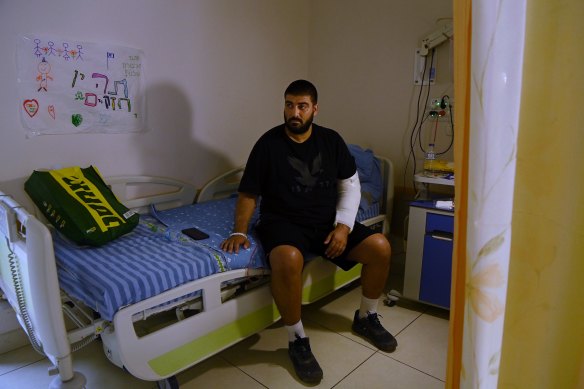
Police officer Daniel Damri recovers from six bullet wounds in the Soroka Medical Centre. Credit: Kate Geraghty
This tranquil vision was shattered when he awoke at 6.30am to the wailing cry of air raid sirens. Hamas, the militant group that rules the Gaza Strip, was firing rockets into Israel – a common occurrence in this land of perpetual conflict. (Be’er Sheva, or Beersheba, will be familiar to many Australians as the site of a famous ANZAC and British victory in World War I.) Picking up his phone to scan the news, Damri realised that something strange and terrifying was happening. Hamas fighters had crossed the border and were rampaging through southern Israel, slaughtering soldiers and civilians alike. Putting on body armour and grabbing his M16 automatic rifle, he rushed to the police command centre. After rustling up a makeshift plan, he hit the highway with a team of fellow officers. Their mission: to take out the Hamas fighters. “We knew we were going into battle, but we didn’t know it would be so big,” he says.
Driving towards Gaza, Damri encountered a car heading towards him. Realising it could be terrorists, he made a U-turn, parked and took aim. He had shot two Hamas terrorists dead. Continuing onto the village of Kibbutz Re’im, he and his fellow officers found the bodies of at least eight young party-goers who had fled a music festival that became a massacre. Damri called for police reinforcements: his team of 10 was outnumbered and outgunned by Hamas fighters armed with high-calibre weapons. They were smart too, wearing Israel Defence Forces uniforms to fool locals into thinking they were there to save them rather than kill them. “They were tough and they knew what they were doing,” he says. He believes the men he encountered were members of the Nukhba, Hamas’s elite military force.
If every word cost a shekel, Damri would be a wealthy man. He speaks matter-of-factly about his experience that day – the deadliest for Jews since the Holocaust. “I had to think fast. I decided I’m leaving my vehicle behind to advance on foot,” he recalls. “I realised that if I don’t keep moving forward I will be trapped. I must keep moving forward.”
As Damri and his fellow officers neared the entrance of the kibbutz they were met with a blizzard of bullets from inside a grove of trees. Gunshots sliced through his legs, his back and his left arm; he collapsed to the ground. The only way he could stop bleeding to death was to press against his wounds with his body weight and a balled-up fist. Unable to talk, the only way he could show a wounded colleague he was still alive was by gently grazing the grass beside him. After three hours like this, an ambulance finally arrived and took him to the Soroka Medical Centre, Israel’s second-biggest hospital. A doctor with 30 years’ experience told him he had never seen a patient suffer so many bullet wounds without one hitting a vital organ.
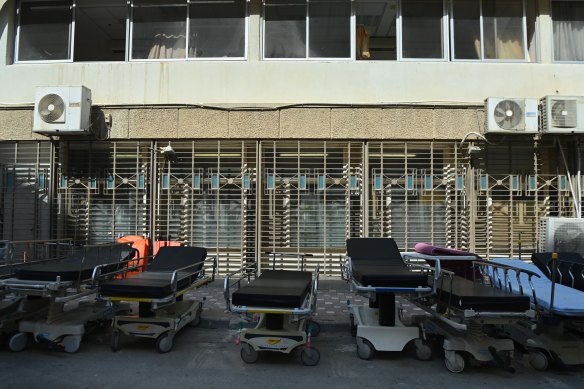
In preparation for the Israeli ground offensive, trolley beds are stationed at the entrances of the Soroka Medical Centre. Ofakim, Israel.Credit: Kate Geraghty
He shouldn’t be alive, yet he is. Each day at the hospital he meets with his fellow officers who survived the attacks. “They are my men, I am their commander. They are like my kids.” Sitting upright on his hospital bed, he wants the world to know the names of two colleagues who died fighting beside him: Uriel Abraham and Alexei Bodovsky. They are among the more than 1300 Israelis who died at the hands of Hamas in a single day.
Officials at Soroka say they have treated more than 900 patients from the attacks, with about 50 still remaining at the hospital. The sense of unity that has erupted in Israel, a nation previously riven with debate about the Netanyahu government’s push to overhaul the judiciary, is palpable here. Volunteers from across the country have streamed in to make coffee and prepare food for staff and patients. At lunchtime, the hospital’s ground floor resembles a rowdy concert hall, with two bands playing songs to lift morale: traditional folk music for a mature crowd in the lobby and Zionist youth rock for an adoring group of girl scouts.
‘Like the Wild West’
Sharing a hospital room with Damri at the Soroka is Shachar Butzchak. He is a rabbi and former Israeli military captain from Ofakim, a town of 30,000 people that sits at the midway point between Be’er Sheva and the Gaza border.
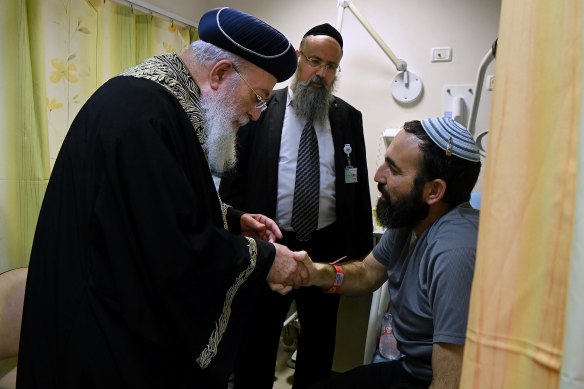
Rabbi Shachar Butzchak (right) is visited by Chief Rabbi of Jerusalem Shlomo Amar.Credit: Kate Geraghty
Like almost everyone else from southern Israel, his story begins with the early morning air sirens. After securing his wife and six children in their home’s emergency shelter, he went out to the street.
Meeting up with a couple of neighbours – also trained military men – they formed a gang of three to take on the terrorists. No one knew exactly what was going on; Butzchak figured his gang was up against a similar number of terrorists. In fact, there were more like 20 Hamas fighters, armed with grenade launchers and machine guns, prowling the town.
“It was like the Wild West,” he says. “Bullets were flying all over the place.” Hopping around behind bomb shelters and ducking behind cars, he fought in close combat, armed only with a pistol. Then he was shot in the thigh and fell to the ground, blood pouring from his leg. A neighbour eventually found him and dragged him inside a house, where he waited for 90 minutes for an ambulance to collect him.
As he recounts this tale, Butzchak’s face lights up with sudden delight. Jerusalem’s Sephardic chief rabbi, Shlomo Amar, enters the ward to express his gratitude. Never could he have imagined a small-town rabbi would be visited by one of the nation’s most important religious figures. He’s proud of what he and his comrades achieved.
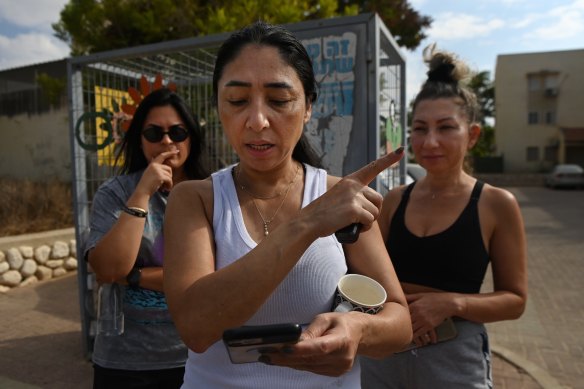
Local residents watch videos of Hamas fighters attacking their town of Ofakim, Israel.Credit: Kate Geraghty
“The terrorists didn’t expect so much resistance,” he says. “This was the best of the best of Hamas. We were wearing flip-flops and pyjamas, and we managed to beat them.” He notes the town received no assistance from the defence force for hours as the terrorists went on their killing spree. “Maybe our pride failed us,” he says of the Israeli military’s unpreparedness for such an attack.
After leaving the hospital, this masthead drives to Ofakim. Along the way, we see Israeli tanks amassed at the border, firing bombshells towards Gaza. Arriving in the town, we visit the road where Butzchak lay bleeding next to a salmon-coloured bomb shelter. Once a thriving textile hub, unemployment soared in Ofakim in the 1990s: just like in the United States “rust belt”, the shift of manufacturing jobs to Asia hit the town hard. Things have improved slightly since, but Ofakim remains a poor town.
The blood has been cleaned from the streets, but you can still see bullet holes in car doors and grenade marks on the roads. A group of local women approach and show us footage of Hamas fighters shooting residents; they point to a house where a renowned physics professor and his wife, aged in their 80s, were shot dead. A few blocks down the road at the local cemetery, mourners have gathered, their heads clad in skull caps and fedoras, to bury Elizabetta Kosticin. The 78-year-old woman was slaughtered by Hamas terrorists while hiding in her home. Nine days after the assault, Ofakim is still burying the estimated 49 residents who died that day.
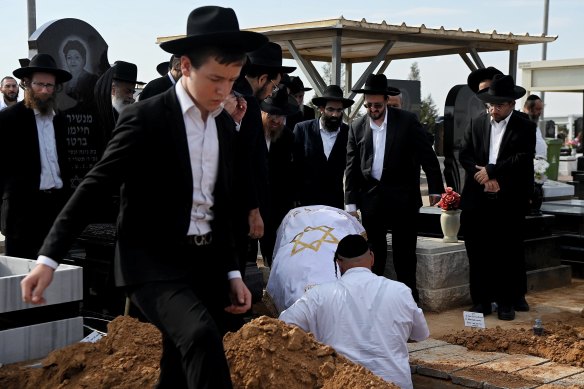
The funeral of Elisabetta Kosticin, 78, at the Ofakim cemetery.Credit: Kate Geraghty
A day of horror
Sitting outside the cemetery is Israel Revach, a man who shares a name with the country he loves. The sound that haunts most from October 7 is not the bombs. Nor the bullets the terrorists sprayed with murderous abandon throughout Ofakim. What haunts him is the macabre symphony of ringtones he heard emanating from inside the body bags. Frantic calls to loved ones who had already left this world and would never pick up the mobile phone vibrating in their pockets.
Unlike policeman Daniel Damri and rabbi Shachar Butzchak, it took Revach several hours to grasp what was happening in his town. Not only was this Shabbat but Simchat Torah, a Jewish high holy day. Revach is an ultra-orthodox Jew, meaning he could not use a phone or turn on the television. It was only when he went to the synagogue that a fellow worshipper told him Hamas terrorists were on the loose. A worried neighbour then knocked on his door to say that her husband had gone for a walk at 6am. It was now midday, and he hadn’t come home. This holy day, it turned out, was a day of horror.
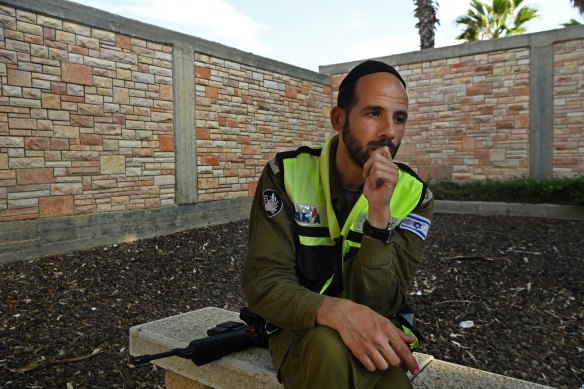
Search and rescue volunteer Israel Revach at the Ofakim cemetery recounts how he helped identify bodies killed in the Hamas attack. Credit: Kate Geraghty
Revach, a volunteer with a local search-and-rescue organisation, sprung to attention and took on the grim task of identifying the deceased. The town’s morgue was full, so a makeshift refrigeration facility was opened at the cemetery. The bodies kept coming and coming, not just from Ofakim but from surrounding towns and kibbutzes. Worse than the gunshot wounds and the stabbings, he says, were the burns suffered by the victims. As he performed his duty for a day without sleep, Revach realised he knew many of the victims, including the husband who went for a morning walk and never returned.
Revach, 39, is a man of action who needs to keep busy to keep the demons at bay. It’s the only way to stop thinking about that girl, aged 17 or so, dressed up for a party, looking so beautiful and full of promise, lying in a body bag with her mobile phone ringing beside her. Was it her father calling, he wonders, checking to see if she was alive? He would like to have answered, but he wasn’t authorised to do so.
“We got hit really hard,” he says of the attack. “The Jewish people have suffered a lot throughout history and we will get through this.”
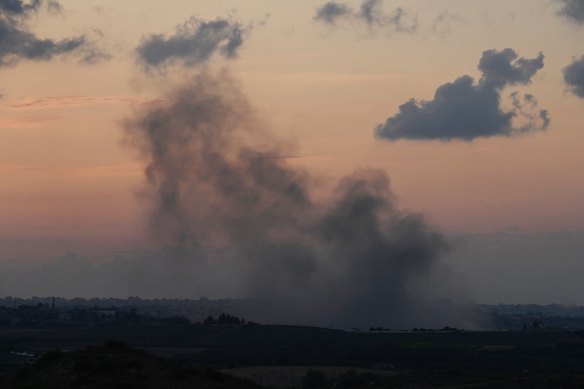
Smoke rises from explosions in the Gaza Strip fired by the Israeli military.Credit: Kate Geraghty
Thinking to the future, and the imminent Israeli ground invasion of Gaza, he feels uneasy, however. “On the one hand, we really want to finish them off once and for all, everybody wants that. But you don’t know what you’re getting into and how you get out of there. We will see body bags piling up here again. Then there are the hostages they have to bring back. It’s a dilemma, it’s not simple.”
Finishing her 12-hour shift at Soroka Medical Centre’s trauma ward, Karina Kyviat feels similarly troubled. The anaesthesiologist, 28, hurried to work on the day of the attack as the hospital struggled to cope with the deluge of patients. They did all they could, but she tortures herself with thoughts of what she could have done differently to keep more people alive. “It was like we failed even though we had a minimal chance of success,” she says.
The hospital has offered a counselling hotline to staff, but the idea of pouring out her feelings to a stranger on the phone doesn’t appeal. Her way of getting through: “You have a drink before bed, you talk to your friends, you say how shit everything is, and you go back to work.” Blessed with a sense of dark humour, she remembers the funny moments too, like the injured soldier, high on medical ketamine, who made everyone laugh with his delirious chatter.
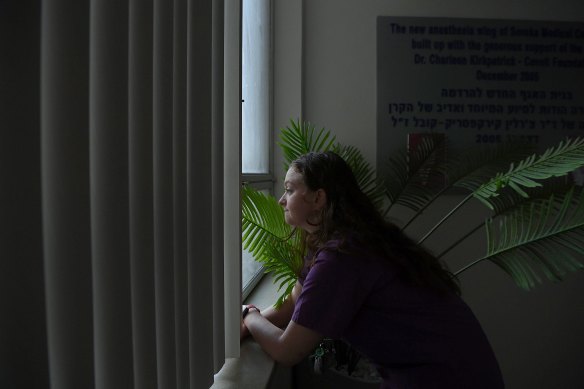
Karina Kyviat in the trauma ward where she worked for hours on patients wounded during the Hamas attack. Be’er Sheva, Israel. Credit: Kate Geraghty
Now, as the number of remaining patients becomes manageable, the hospital staff are preparing for another tsunami when the ground invasion of Gaza begins. “We’re trying to catch our breath because we know the next wave is going to come,” Kyviat says. Already, she can see the international community’s support for Israel fading because of footage of neighbourhoods in Gaza being blown to rubble by Israeli air bombardments. At least 2750 Palestinians are estimated to have died in Israel’s retaliatory attacks.
They are sayings as true as they are clichéd: violence begets violence and hate begets hate. The people who live on this tiny patch of Earth have already suffered more than enough bloodshed, yet more is on the way.
Get a note directly from our foreign correspondents on what’s making headlines around the world. Sign up for the weekly What in the World newsletter here.